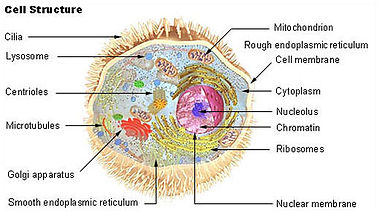Cell biology
| Part of a series on |
| Biochemistry |
|---|
 |
| Key components |
| History and topics |
| Glossaries |
| Portals: Biology, MCB |
History[edit]
Cell structure[edit]
Internal cellular structures[edit]
Chemical and molecular environment[edit]
Organelles[edit]
Processes[edit]
Growth and development[edit]
Other cellular processes[edit]
- Active transport and Passive transport - Movement of molecules into and out of cells.
- Autophagy - The process whereby cells "eat" their own internal components or microbial invaders.
- Adhesion - Holding together cells and tissues.
- Cell movement - Chemotaxis, contraction, cilia and flagella.
- Cell signaling - Regulation of cell behavior by signals from outside.
- Division - By which cells reproduce either by mitosis (to produce clones of the parent cell) or Meiosis (to produce haploidgametes)
- DNA repair - Cell death and cell senescence.
- Metabolism - Glycolysis, respiration, photosynthesis, and chemosynthesis.
- Signalling - The process by which the activities in the cell are regulated.
- Transcription and mRNA splicing - Gene expression.
Notable cell biologists[edit]
©Aah.Towfiq
®Atps.Plus™call:- +8801978698786


Comments
Post a Comment
Here all information related to medical and doctoral health is published. Visit any of these languages in your language to see your language.